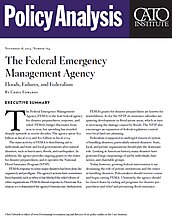FEMA’s response to some major disasters has been slow, disorganized, and profligate. The agency’s actions have sometimes been harmful, such as when it has blocked the relief efforts of other organizations. FEMA’s dismal response to Hurricane Katrina in 2005 dramatized the agency’s bureaucratic dysfunction. FEMA’s grants for disaster preparedness are known for wastefulness. As for the NFIP, its insurance subsidies are spurring development in flood-prone areas, which in turn is increasing the damage caused by floods. The NFIP also encourages an expansion of federal regulatory control over local land-use planning.
Federalism is supposed to undergird America’s system of handling disasters, particularly natural disasters. State, local, and private organizations should play the dominant role. Looking at American history, many disasters have generated large outpourings of aid by individuals, businesses, and charitable groups.
Today, however, growing federal intervention is undermining the role of private institutions and the states in handling disasters. Policymakers should reverse course and begin cutting FEMA. Ultimately, the agency should be closed down by ending aid programs for disaster preparedness and relief and privatizing flood insurance.

